Did you know that a single asparagus plant can produce spears for up to 20 years? That’s right! With the right knowledge and care, you can enjoy a bountiful harvest of this delicious perennial vegetable for decades to come. And the best part? It all starts with planting asparagus seeds. In this comprehensive guide, I will share with you valuable tips and tricks to ensure your asparagus seeds grow into thriving plants that yield mouthwatering spears. Get ready to embark on an exciting journey of growing your own asparagus and relishing in its delectable flavors.
Key Takeaways:
- Planting asparagus seeds can provide you with a continuous harvest of this perennial vegetable for up to 20 years.
- With the right tips and tricks, you can successfully grow asparagus from seeds and enjoy its delicious spears.
- This comprehensive guide will equip you with the knowledge to create the ideal growing conditions, plant, care for, harvest, and expand your asparagus bed.
- Learn how to overcome common pests and diseases and maintain the health of your asparagus plants.
- Start your journey to growing perfect asparagus from seeds and savor the rewards of a homegrown perennial crop.
Why Choose Asparagus Seeds?
When it comes to growing asparagus, choosing the right seeds is essential. Asparagus seeds offer a range of benefits, making them a popular choice among gardeners. Whether you’re interested in organic produce, heirloom varieties, or a perennial vegetable that will keep on giving, asparagus seeds have got you covered.
By opting for asparagus seeds, you have the opportunity to grow organic asparagus. Organic gardening has gained immense popularity in recent years, as people become more conscious of the chemicals used in conventional farming. With organic asparagus seeds, you can enjoy delicious, pesticide-free spears on your dinner table.
In addition, asparagus seeds allow you to explore the world of heirloom varieties. These unique and rare cultivars have been passed down through generations, preserving their exceptional flavors and characteristics. By growing heirloom asparagus from seeds, you can experience the joy of cultivating these cherished varieties in your own backyard.
“Asparagus plants have been cultivated for centuries, and heirloom varieties provide a glimpse into the rich history of this beloved vegetable. Their unique flavors and textures are a true delight for any gardening enthusiast.”
Furthermore, asparagus is a perennial vegetable, meaning that once you plant the seeds, you can enjoy the harvest for years to come. Asparagus plants have a long lifespan and can continue to produce fresh spears for over 20 years. This makes them a wise investment, saving you time and effort in replanting each year.
If you’re ready to embark on a journey of growing your own delicious and sustainable asparagus, choosing asparagus seeds is the way to go.
Benefits of Choosing Asparagus Seeds:
- Growing organic asparagus
- Exploring heirloom varieties
- Enjoying a perennial harvest
Best Varieties of Asparagus Seeds
When it comes to choosing asparagus seed varieties, there are a few exceptional options that stand out for their quality and performance. Whether you prefer heirloom asparagus seeds or are looking for the best asparagus seed suppliers, these varieties are sure to meet your needs.
1. Millennium: Known for its excellent vigor and disease resistance, Millennium asparagus seeds are a popular choice among growers. This variety produces thick, tender spears that are perfect for both cooking and fresh consumption.
2. The Jersey Series: Consisting of popular varieties like Jersey Giant, Jersey Knight, and Jersey Supreme, the Jersey series offers a range of options for asparagus lovers. These hybrids are highly productive and well-suited for various growing conditions.
3. Mary Washington: A classic heirloom variety, Mary Washington boasts reliable yields and an excellent flavor profile. This asparagus seed variety adapts well to different climates and is renowned for its high tolerance to cold temperatures.
4. Viking KB-3: If you’re looking for a cold-hardy asparagus variety, Viking KB-3 is an excellent choice. It thrives in regions with harsh winters, making it a reliable option for growers in colder climates.
5. Purple Passion: As the name suggests, Purple Passion asparagus seeds produce striking purple spears that add a pop of color to your garden and plate. This variety is not only visually appealing but also delivers a delicious taste.
Each of these asparagus seed varieties has its unique characteristics, providing options based on vigor, yield, cold-hardiness, and flavor. Whether you’re a seasoned gardener or just starting, these varieties will help you grow a successful asparagus crop.
| Asparagus Seed Variety | Characteristics |
|---|---|
| Millennium | Excellent vigor and disease resistance |
| The Jersey Series | Productive hybrids adaptable to various conditions |
| Mary Washington | Reliable yields and high cold tolerance |
| Viking KB-3 | Cold-hardy variety suitable for harsh winters |
| Purple Passion | Eye-catching purple spears with great taste |
Creating the Ideal Growing Conditions for Asparagus Seeds
When it comes to growing asparagus seeds, creating the ideal growing conditions is essential for a successful harvest. Here are some key factors to consider:
Soil pH
The pH level of the soil plays a crucial role in the growth and development of asparagus seeds. The optimal pH range for asparagus is between 6.5 and 7.0. This slightly acidic to neutral pH creates an ideal environment for nutrient absorption and root development.
Soil Fertility
Asparagus plants require fertile soil to thrive. Before planting, it’s important to test the soil for nutrient levels and adjust accordingly. Adding organic matter, such as compost or well-rotted manure, can help improve soil fertility and provide essential nutrients for healthy growth.
Soil Moisture
Consistent soil moisture is crucial for the growth and vitality of asparagus seeds. Adequate moisture levels support root development and encourage the production of robust ferns. However, it’s important to strike a balance and avoid overwatering, as excessively wet soil can lead to root rot.
Soil Testing
Regular soil testing is a valuable practice to ensure the ongoing health and fertility of your asparagus bed. Testing the soil allows you to determine nutrient deficiencies or imbalances and make informed decisions about fertilization. It’s recommended to perform a soil test every one to three years to maintain optimal growing conditions.
Quote:
“Creating the ideal growing conditions for asparagus seeds is like laying the foundation for a successful harvest. By prioritizing soil pH, fertility, moisture, and regular testing, you can cultivate healthy plants that produce a bountiful crop.”
Summary:
To create the ideal growing conditions for asparagus seeds, focus on maintaining a pH level between 6.5 and 7.0, ensuring soil fertility through organic matter, providing consistent soil moisture, and conducting regular soil testing. These practices will help you establish a strong foundation for healthy asparagus plants and a prolific harvest.
| Factors | Ideal Conditions |
|---|---|
| Soil pH | 6.5 – 7.0 |
| Soil Fertility | Rich in organic matter, balanced nutrient levels |
| Soil Moisture | Consistently moist, well-drained |
| Soil Testing | Regular testing every 1-3 years |
Planting Asparagus Seeds
Planting asparagus seeds is an exciting way to start your own asparagus patch. Whether you choose to plant them directly in the garden or start them indoors, proper planting methods are essential for success.
Planting Methods for Asparagus Seeds
There are two main planting methods for asparagus seeds:
- Direct planting in the garden
- Starting seeds indoors and transplanting
Let’s explore each method in detail:
Direct Planting in the Garden
“Digging trenches and spacing the seeds or crowns properly is the traditional method for direct planting of asparagus seeds.”
To directly plant asparagus seeds in the garden, follow these steps:
- Choose a sunny location with well-drained soil.
- Prepare the soil by removing weeds and adding compost for added fertility.
- Dig trenches that are 6-12 inches deep and 18-24 inches wide.
- Space the seeds approximately 2-3 inches apart within the trenches.
- Cover the seeds with 1-2 inches of soil.
- Water gently to ensure the soil is evenly moist.
Starting Seeds Indoors and Transplanting
“Starting asparagus seeds indoors allows for better control over the growing conditions and early establishment of the plants.”
If you prefer to start your asparagus seeds indoors, follow these steps:
- Sow the seeds in pots or seed trays filled with a well-draining soil mix.
- Keep the soil consistently moist but not waterlogged.
- Place the pots or trays in a warm location with plenty of sunlight or under grow lights.
- Once the seedlings emerge and grow to a height of 6-8 inches, they are ready to be transplanted.
- Choose a permanent location in the garden and prepare the soil as described earlier.
- Carefully transplant the seedlings, spacing them 12-18 inches apart.
- Water gently after transplanting to help the seedlings establish.
Whichever method you choose, it’s important to maintain consistent soil moisture and provide proper care to ensure the healthy growth of your asparagus seeds.
Caring for Asparagus Seeds
Proper care is essential for the healthy growth and development of asparagus seeds. Here are some important tips to ensure their well-being:
1. Soil Moisture:
Asparagus seeds require consistent soil moisture, especially during the harvest season. The soil should be moist but not waterlogged. Regularly check the soil moisture levels by inserting your finger into the soil about an inch deep. If it feels dry, it’s time to water.
2. Watering Asparagus Seeds:
Water your asparagus seeds deeply and infrequently to encourage deep root growth. Aim to provide about 1 inch of water per week, either through rainfall or irrigation. Water directly at the base of the plants to avoid wetting the foliage excessively, as this can lead to disease.
3. Fertilizing Asparagus Seeds:
Asparagus seeds benefit from regular fertilization to ensure proper nutrient uptake. Apply a balanced fertilizer, such as a 10-10-10 or a fertilizer specifically formulated for vegetables, in early spring before the spears emerge. Follow the manufacturer’s instructions for application rates and timing.
4. Mulching:
Mulching around your asparagus seeds can help conserve soil moisture, suppress weed growth, and regulate soil temperature. Apply a layer of organic mulch, such as straw or shredded leaves, around the plants, leaving a gap around the base to prevent rotting. Replenish the mulch as needed throughout the growing season.
5. Regular Soil Testing:
Regularly test your soil to assess its nutrient levels and pH. Asparagus seeds prefer a slightly acidic to neutral soil pH between 6.5 and 7.0. Adjust the pH and nutrient levels as needed based on the recommendations from the soil test results.
Note: Remember to water your asparagus seeds consistently, ensure proper fertilization, and regularly test the soil for optimal growth and harvest. By following these care guidelines, you can expect healthy root and fern growth, leading to bountiful asparagus harvests.
Table: Nutrient Requirements for Asparagus Seeds
| Nutrient | Recommended Amount |
|---|---|
| Nitrogen | 1-2 pounds per 100 square feet |
| Phosphorus | 0.5-1 pound per 100 square feet |
| Potassium | 1-2 pounds per 100 square feet |
By providing adequate soil moisture, proper watering and fertilizing, mulching, and regular soil testing, you can ensure the health and productivity of your asparagus seeds. These care practices will support root and fern growth, leading to a thriving asparagus patch.
Harvesting Asparagus Seeds
Harvesting asparagus is an exciting milestone in your gardening journey. When it comes to asparagus seeds, the timing and techniques for harvesting are essential to ensure optimum flavor and quality. Here’s a guide to help you know when and how to harvest your asparagus seeds.
When to Harvest Asparagus
Asparagus spears can be harvested when they reach the right size and thickness. For asparagus seeds, it is recommended to wait until two years after planting crowns or three years after planting seeds before starting the harvest. This allows the plants to establish strong root systems and produce robust spears.
The ideal spear size for harvesting asparagus seeds is around 8 to 10 inches in height and 1/2 to 3/4 inch thick. Spears within this range are tender, flavorful, and have a delightful crunch. Be careful not to let the spears grow too tall, as they may become tough and fibrous.
Harvesting Techniques
When it’s time to harvest your asparagus seeds, it’s important to use the proper techniques to minimize damage to the plant. To harvest, use a sharp knife or garden shears to cut the spears just below the soil level. Make a clean, angled cut to avoid leaving stubs, which can attract pests and lead to disease.
Regular harvesting of your asparagus seeds is important to encourage continuous spear production. During the harvest season, check your asparagus bed every 1-2 days and harvest any spears that meet the size and thickness requirements. However, it’s essential not to overharvest. Avoid harvesting more than the diameter of a pencil at one time, as this can put stress on the plant and reduce future spear production.
“Harvesting asparagus is like an art – it requires precision and patience. By following the right timing and techniques, you can enjoy a bountiful harvest of delicious asparagus seeds.”
Now that you know the right time to harvest and the proper techniques, get ready to enjoy the fruits of your labor. Freshly harvested asparagus seeds are perfect for a variety of culinary creations, from roasted dishes to refreshing salads.
Next, we’ll explore how to take care of your asparagus seeds during the fall and winter months. Find out the best practices for overwintering and maintaining the health of your asparagus plants.
Overwintering and Maintenance for Asparagus Seeds
Asparagus seeds require specific care during the fall and winter months to ensure their health and readiness for the next growing season. Proper maintenance practices not only protect the plants from harsh weather conditions but also promote their overall growth and longevity. Here are some essential tips for overwintering and maintaining asparagus seeds:
1. Removing Dead Foliage
Before the first frost sets in, it is crucial to remove any dead foliage from the asparagus bed. Cut the ferns down to ground level, taking care not to damage the crowns. This practice prevents the accumulation of disease and pest harboring sites, ensuring a clean start for the following spring.
2. Side-Dressing with Compost
Supplying additional nutrients to the soil during the fall helps fortify the asparagus plants and replenish any nutrient deficiencies. One effective method is to side-dress the asparagus bed with compost. Spread a layer of well-rotted compost around the plants, making sure to keep it away from the crown area. The compost acts as a slow-release fertilizer, enhancing soil fertility for the upcoming growing season.
3. Mulching the Bed
Applying a layer of mulch to the asparagus bed offers protection against extreme temperature fluctuations and helps retain soil moisture. Spread a 2-3 inch layer of organic mulch, such as straw or shredded leaves, over the exposed soil. This will provide insulation, prevent weed growth, and conserve moisture, providing an ideal environment for the dormant asparagus crowns.
4. Monitoring Moisture Levels
Even during the winter months, it is crucial to monitor the moisture levels in the asparagus bed. Adequate soil moisture prevents dehydration of the crowns and ensures their survival. Make sure the soil is consistently moist but not waterlogged to avoid root rot and crown damage.
By following these maintenance tips, you can provide the necessary care for your asparagus seeds during the fall and winter months. Properly overwintered plants will emerge healthy and vigorous in the spring, ready to provide a bountiful harvest.
| Benefits of Overwintering and Maintenance for Asparagus Seeds: |
|---|
| 1. Protection against harsh weather conditions |
| 2. Prevention of disease and pest infestation |
| 3. Fortification of plant health and longevity |
| 4. Enhanced soil fertility |
| 5. Moisture conservation for healthy crown development |
Common Pests and Diseases for Asparagus Seeds
Growing asparagus from seeds takes patience and care. However, asparagus plants can be vulnerable to various pests and diseases that can hinder their growth. Being aware of common asparagus pests and diseases and effectively managing them is crucial for a successful crop.
Pests
One of the most common pests that affect asparagus plants is the asparagus beetle. These beetles can cause severe damage by feeding on the foliage and laying eggs that hatch into hungry larvae. Regular inspection is essential to detect early signs of infestation.
“Asparagus beetle larvae can defoliate plants, reducing their vigor and yield. Adult beetles consume both foliage and berries.”
Other pests that may affect asparagus include slugs, snails, and aphids. These pests can cause significant damage if left uncontrolled. Implementing organic pest control methods such as handpicking, companion planting, or using natural predators can help manage pest populations effectively.
Diseases
Asparagus plants can also be susceptible to various diseases, with fusarium wilt being a prevalent concern. Fusarium wilt is a fungal disease that invades the vascular system, impairing the plant’s ability to transport essential nutrients and water.
“Fusarium wilt can cause stunted growth, yellowing or browning of foliage, and wilting of the plant. The disease can persist in the soil, affecting subsequent asparagus crops.”
Other common diseases that can affect asparagus plants include crown rot, rust, and purple spot. Preventive measures such as practicing crop rotation, maintaining proper plant spacing, and providing adequate air circulation can help reduce the risk of disease development.
Pest and Disease Management
Effective pest and disease management techniques are essential for preserving the health and productivity of asparagus plants. Here are some key strategies to consider:
- Regularly inspect plants for pests and diseases, paying close attention to the foliage, stems, and berries.
- Remove any infected or infested plant parts promptly to prevent the spread of pests or diseases.
- Implement integrated pest management (IPM) practices, including cultural, biological, and organic control methods.
- Encourage natural predators such as ladybugs, lacewings, and parasitic wasps to help control pest populations.
- Apply organic insecticides or fungicides when necessary, following the instructions carefully.
- Maintain proper plant nutrition and soil fertility to enhance plant vigor and resilience against pests and diseases.
By employing these pest and disease management techniques, you can minimize the impact of pests and diseases on your asparagus crop, ensuring healthy plants and a bountiful harvest.
| Pest | Description |
|---|---|
| Asparagus Beetle | Feeds on foliage and lays eggs, leading to defoliation and reduced vigor |
| Slugs and Snails | Cause damage by feeding on foliage and stems |
| Aphids | Suck sap from plants, causing distorted growth and spreading of diseases |
| Disease | Description |
|---|---|
| Fusarium Wilt | Fungal disease that affects the vascular system, causing wilting and stunted growth |
| Crown Rot | Fungal infection that affects the crown, leading to rotting and plant death |
| Rust | Fungal infection that causes rust-colored spots on foliage |
Expanding Your Asparagus Bed
Once you have successfully grown asparagus from seeds, you may find yourself wanting to expand your asparagus patch. Luckily, there are two effective methods for doing so: transplanting and dividing. Both techniques allow you to create a larger asparagus bed and increase your harvest.
Transplanting Asparagus
Transplanting asparagus is a great option if you have established plants that you want to move to a different location. It’s best to perform this task during the plant’s dormancy period in early spring or late fall. Here’s how you can transplant your asparagus:
- Select a new location for your asparagus bed that meets the same growing conditions as the original site, such as well-drained soil and full sun.
- Carefully dig up the asparagus crowns, ensuring you don’t damage the delicate roots.
- Replant the crowns at the new location, making sure to provide enough space between each crown to allow for future growth.
- Water the transplanted crowns thoroughly and continue to monitor their progress as they adjust to their new environment.
Dividing Asparagus
Dividing asparagus plants is a method used to propagate new plants from existing ones. It’s an excellent way to expand your asparagus patch and prevent overcrowding. Follow these steps to divide your asparagus plants:
- Choose mature asparagus plants that are at least three years old.
- During the plant’s dormancy period in early spring or late fall, dig up the mature plants.
- Gently separate the crowns into smaller sections, ensuring that each division has its own set of roots.
- Replant the divided sections in a new asparagus bed or in different areas of your existing bed.
- Water the divided sections thoroughly and provide regular care as they establish themselves in their new locations.
Both transplanting and dividing asparagus plants require careful attention to ensure the success of the new growth. Be patient and give the transplanted or divided plants time to establish themselves in their new locations. With proper care and maintenance, your expanded asparagus bed will provide you with a bountiful harvest for years to come.
Conclusion
Growing asparagus from seeds can be a rewarding experience that allows you to enjoy a bountiful perennial crop. By following this comprehensive planting guide and utilizing the tips and tricks provided, you can ensure the success of your harvest.
Throughout this guide, we have explored the benefits of using asparagus seeds, the best varieties to choose from, creating ideal growing conditions, planting methods, caring techniques, harvesting tips, overwintering and maintenance practices, as well as managing common pests and diseases.
With proper guidance and care, you can create the ideal environment for your asparagus seeds to thrive. Remember to pay attention to soil pH, fertility, and moisture, as well as proper watering and fertilizing techniques. Regular harvesting at the right spear size is important to maintain a healthy crop. And don’t forget to follow the necessary steps for overwintering and maintaining your asparagus bed.
By implementing the tips and tricks outlined in this planting guide, you can successfully grow asparagus from seed and enjoy the delicious and nutritious rewards for years to come. Happy gardening!

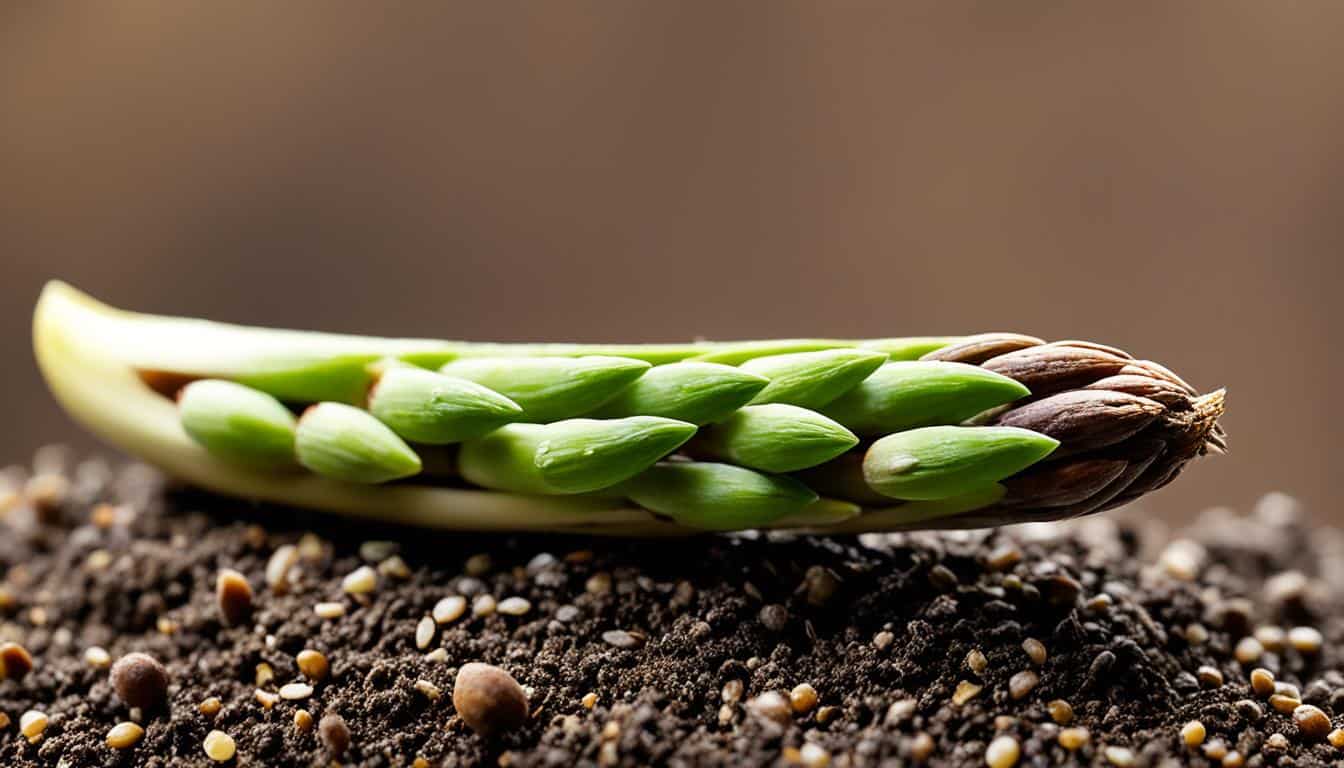
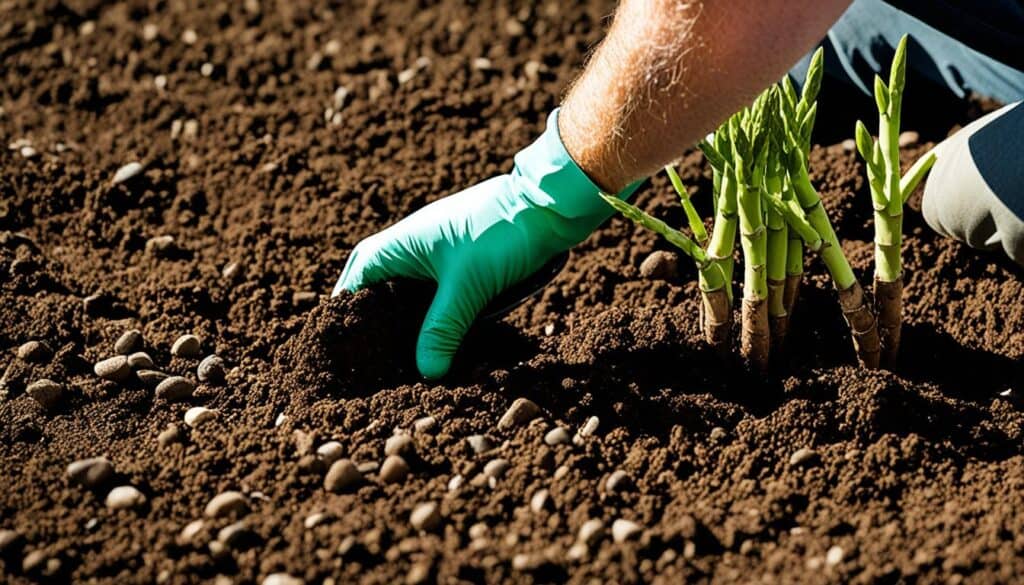
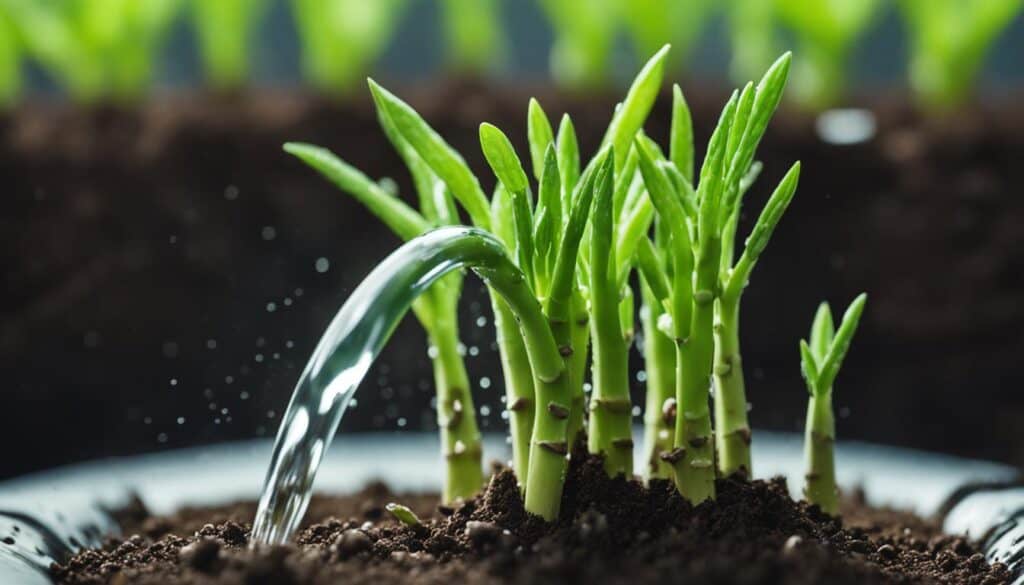
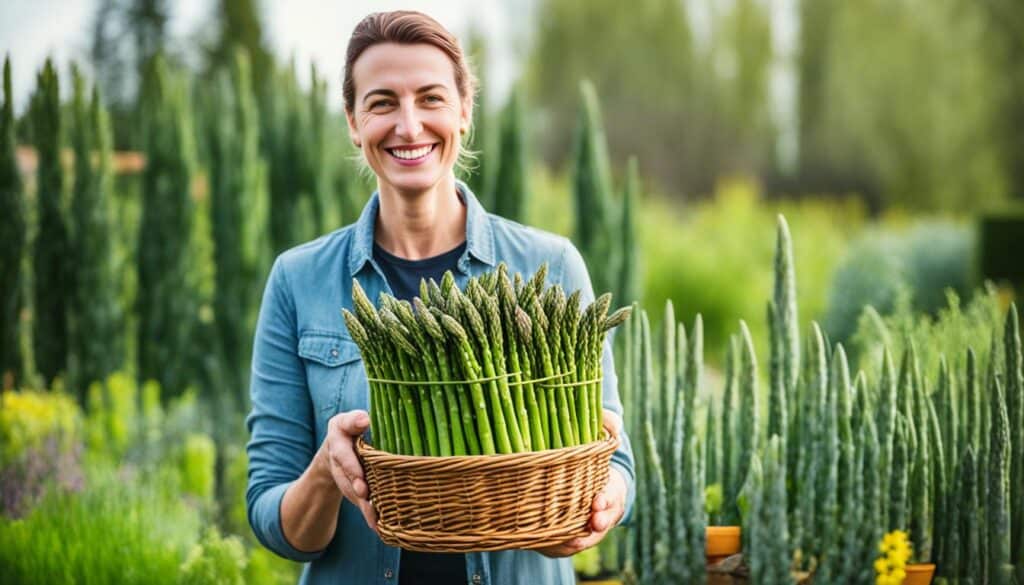

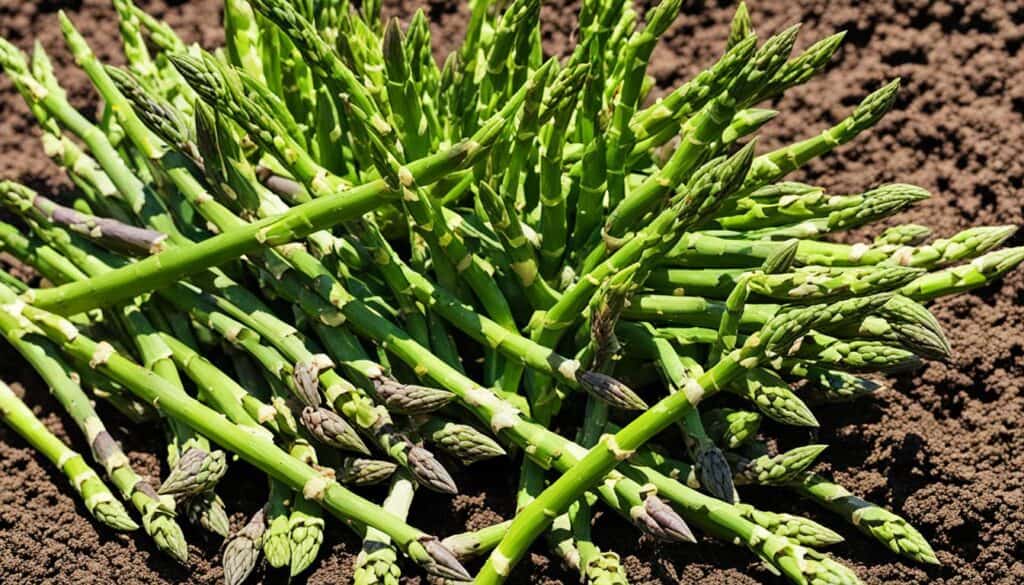



Leave a Reply